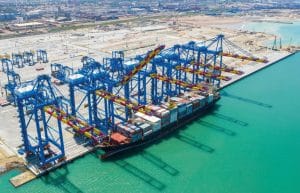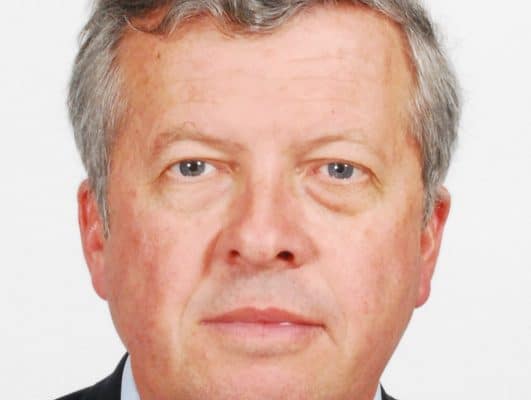Bolloré Ports is experimenting with a new approach in its port handling activities in Africa. The subsidiary of the French group Bolloré has just launched the Green Terminal label to reduce the environmental impact of its terminals and accelerate its energy transition. To find out more about this new approach, Afrik 21 spoke to Olivier de Noray, Managing Director of Port & Terminals at Bolloré Ports.
AFRIK 21: What does the Green Terminal label represent for your group?
Olivier de Noray (CEO of Port & Terminals of Bolloré Ports): The Green Terminal is a new approach in line with our CSR strategy. This labelling process is the result of a real reflection process started several years ago to further reduce our carbon footprint. Wishing to go even further and to unite our employees around a meaningful project, we approached Bureau Veritas [a company specialising in certification, editor’s note] to have our approach analysed and validated on the basis of a global approach. This involved taking into account all environmental concerns, from the implementation of an optimised management system to the training of our employees in good practices related to environmental issues. The Green Terminal label is the ultimate ambition of a terminal that combines operational and environmental performance. It also integrates social and governance criteria into its process so that we can continue to invest sustainably in the areas where we operate.
Is it possible to measure the environmental impact of port activities?
Yes, we initiated this process more than 8 years ago through our own CSR programme, in accordance with the various existing national laws. Today, with new technologies and more environmentally friendly equipment (notably e-RTGs), which are now operational, we can measure the environmental impact of port activities based on performance indicators that are part of the implementation of the label. For example, from 2019 to 2020, direct greenhouse gas emissions, which fall under scope 1, and more indirect emissions, linked to energy consumption, which fall under scope 2, decreased by 6% at some of our 13 container terminals thanks to the acquisition of new electric equipment and their connection to the public electricity network. This effort will continue in 2022 and 2023 with the commissioning of new container terminals.
Your port platforms receive large ships that are known for their fairly high level of pollution. Can CO2 emissions really be reduced at your port platforms?
Yes, but it must be said that this issue goes beyond our scope of activity and that it is up to the Port Authority to engage in an environmental process to reduce CO2 emissions according to a master plan applicable by the port operators.
What link do you make between the digitalisation of facilities and the reduction of their environmental impact?
The dematerialisation of transport documents has several advantages and makes it possible to facilitate exchanges while reducing air pollution and congestion in ports.

The container terminal at the port of Tema in Ghana© Bolloré Ports
We have launched several digitisation projects that will enable us to reduce our carbon impact in terms of scope 3, i.e. the indirect emissions generated by the transport of employees, customers and partners in connection with our port activities.
We are currently working on the implementation of an e-payment system throughout the network, interfaced with the IES web portal developed internally, which should eventually be the preferred method of payment. We have also deployed collaborative electronic platforms, also known as the “Cargo Community System”, to centralise all administrative documents and customs formalities with the aim of reducing customer travel and thus reducing greenhouse gas emissions linked to our activities.
To what extent are you going to implement an energy transition process in your port platforms? Do you have any concrete solutions?
The energy transition process applies to all new terminals as well as those that have been modernised or extended. On the infrastructure side, we favour the construction of green buildings to contribute to our carbon reduction objectives. Ultimately, our ambition is to obtain EDGE (Excellence in Design for Greater Efficiencies) certification from IFC, a member of the World Bank, for each new project. For the time being, the Tema container terminal in Ghana is the first to have obtained this certification for all its buildings and in particular the mechanical workshop. It will soon be followed by Ivory Coast Terminal (CIT), the second container terminal in the port of Abidjan, which should start operations in the second half of 2022. As far as equipment is concerned, we now have fully electric quay gantries (STS) in all our terminals and we have also started the gradual renewal of our fleet gantries (RTG) in favour of e-RTG. Finally, we have acquired electric tractors co-developed with Blue Solutions, a subsidiary of the Bolloré Group and Gaussin to equip Abidjan Terminal and Ivory Coast Terminal.
What about waste recovery, water treatment and air control?
We have set up a waste recovery process with partner companies and approved in the various states. Waste oil, which is the main waste from terminals in Africa, is subject to specific treatment. In 2020, almost 68% of their production was recycled.
Is there a cost for the Green Terminal label?
We spend 10% of our total infrastructure budget on greening our ports through the construction of sustainable buildings. At the same time, we also invest in electric handling equipment, which is much more expensive depending on the type of equipment. However, these investments are necessary to accelerate this energy transition. Between 2019 and 2020, GHG emissions have been reduced by 11% thanks to the acquisition of electric handling equipment, and this reduction should continue in the coming years.
Interview by Jean Marie Takouleu







You must be logged in to post a comment.